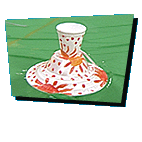 your results your results
Sent in by:
Lauren and Emily of Orange City, IA
Soap up for speed!

- 4 Styrofoam plates
- 2 Styrofoam bowls
- 2 Styrofoam cups
- 2 bendy straws
- glue
- water
- liquid dish soap
- inflatable wading pool or bathtub filled with water

- Check with an adult before you begin. You'll need a place to experiment with your boats like the bathtub or an inflatable wading pool. Make sure it's okay to fill up the tub or wading pool before you get started.
- To make a boat, glue two plates together face to face so that their top edges meet.
- Glue the bowl upside down on top of one of the plates.
- Poke a hole near the bottom of the cup and glue the bottom of the cup to the bottom of the bowl.
- Put the short end of the bendy straw through the hole in the cup. The other end of the straw should point down.
- Make two boats. When the glue dries, decorate your boats with paints or markers.
- To make your boat move, just set it on the water, pour water into the cup and watch it go.
- Now here's where things get sudsy. In the ZOOMphenom, Soap Powered Boat, you can make an index card boat move through water using only liquid dishwashing soap. If soap makes that boat go, won't it make your water-powered boat go faster? To try it out, mix some liquid dishwashing soap with water and pour it into the cup on top of one boat. Pour plain water into the cup on the other boat.
- Race the water-powered boat with the soapy-water-powered boat. Then write to ZOOM with your race results. Did one boat go faster than the other? Why do you think it did or didn't? What other liquids might affect the speed of your boats? Try powering a boat with fizzy water, sugar water or any other kind of liquid you can think of. Then write to ZOOM and let us know what you've discovered.
Lathered-up for the science scoop? When you put water into a cup without a hole, the water pushes on the cup in all directions. When you put a hole in the cup, part of the cup is missing, so the water can no longer push there. But the water is still pushing on the other parts of the cup. That's what moves the cup and the boat along.
What's all the suds about soap, you ask? The attraction between water particles at the water's surface produces surface tension. This gives the surface a skin-like quality. Think of this thin, skin-like quality like a balloon. Adding liquid soap is like popping the balloon. You break the surface tension; the thin "skin" breaks and pulls away to the sides. If there's something floating on these water particles, like the boat, it goes along for the ride.

Helen, age 7 of Bronx, NY wrote:
it floated and then I splashed the water, but it still floated.
Natalie, age 12 of San Francisco, CA wrote:
I used wax paper instead and cut a slot near the end. It worked brilliantly! Any soap pretty much will work.
Adriana, age 12 of Dominica wrote:
it worked!!! and then me and my friend had a race she won!!!
Dylan, age 8 of Redwood City wrote:
it sailed across the bathtub!!!
Samra, age 8 of Los Angeles, CA wrote:
When I did it the orange juice went the fastest because it broke the surface faster. It was a lot of fun. Try it!
Regina, age 14 of Honolulu, HI wrote:
The boat went really fast on the water. It was zooming. But, I sank after a few minutes. I only used dishwasing liquid and the clothes powder soap.
Kaushik, age 9 of Fremont, CA wrote:
The soap acted as an engine.
Harrison, age 9 of Cincinnati, OH wrote:
I did this experiment and it worked really well. It went faster when I put in dishwashing soap. I also tried using other soaps. It was a really fun experiment to do. Be careful if you give your boat too big of a boost, because it might "cupsize".
Ayush, age 9 of Columbus, OH wrote:
Well, when I did it the boat at first went really fast. After some time the boat sank in the water. When I tried to put the boat back on the water the boat wouldn't stay. It kept drowning. That is what happened when I did this experiment.
Laura, age 13 of Falls Church, VA wrote:
I tested this experiment using the cardstock paper boat in my sink. I tested it with two types of hand soap, dish soap, bubble bath, and hair gel. When I did this it worked for both types of hand soap and with the bubble bath and dish soap. The dish soap worked the best. The hair gel didn't work at all.
Brittney, age 11 of Jennings, MO wrote:
The boat did not work but it was really fun makeing it.
Ethan, age 6 of Atlanta, GA wrote:
Boat moved great across the water but got wet and sank after a few minutes.
Club Zoom After School Class of MA wrote:
We felt that a thicker slot on the card worked best. Our triangle shaped boats worked awesome. We changed the water after every try. We tried circle, triangle and square shaped boats and ran trials. The circle shaped boat worked well and we were surprised. It went faster and farther than the square boat.
|



